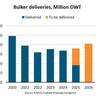Effective April 5, the USCG will increase the requirements for on-water oil recovery capability for tank vessel and facility response plan holders by 25 percent. The so-called response capability "caps" address the volume of equipment a plan holder is required to ensure available by contract or other approved means. The caps ? meant to facilitate the cascading of response resources to a spill scene within the first 72 hours of an incident ? do not relieve a vessel owner of the statutory responsibility to plan for and clean up a worst case discharge, defined by the OPA 90 as the loss of a vessel's entire cargo in adverse weather.
Reflecting the agreement of the Tank Vessel Response Plans Negotiated Rulemaking (Reg-Neg) Committee and the provisions of the January 1996 final rule on tank vessel response plans, the 25 percent cap increase was originally scheduled to take place February 18, 1998, provided the USCG determined the proposed increase was still practicable.
The USCG delayed implementation of the cap increase pending completion of a feasibility review, which examined issues such as technological capability, commercial and market availability of response equipment, and availability of existing equipment stocks to respond within the prescribed time frames.
In May 1999, the USCG completed its review, concluding the volume and placement of existing response equipment stocks are such that a 25 percent increase in the caps is practicable. The 25 percent increase applies directly to containment boom, skimming capacity, and temporary storage capacity. The USCG also expects plan holders to ensure that the resources required to deploy the additional equipment (trained personnel, boats, etc.) are increased as necessary.
The tank vessel response plan regulations call for an additional 25 percent cap increase in 2003. The USCG will consider the need for and feasibility of this scheduled increase, along with related issues such as high-rate response techniques (e.g., dispersants, in situ burning) and improvements in oil tracking technology, in a subsequent rulemaking.
Sponsored Content
Safer Starts Here: Build Ships, Protect Crews

July 2025
 Read the Magazine
Read the Magazine

 Read the Magazine
Read the Magazine
This issue sponsored by:

The Golden Ticket – VIP access & invitation to take an active role in History
Subscribe for
Maritime Reporter E-News
Maritime Reporter E-News is the maritime industry's largest circulation and most authoritative ENews Service, delivered to your Email five times per week







